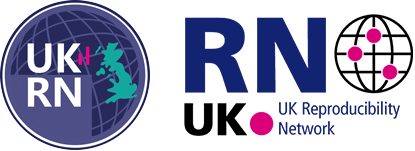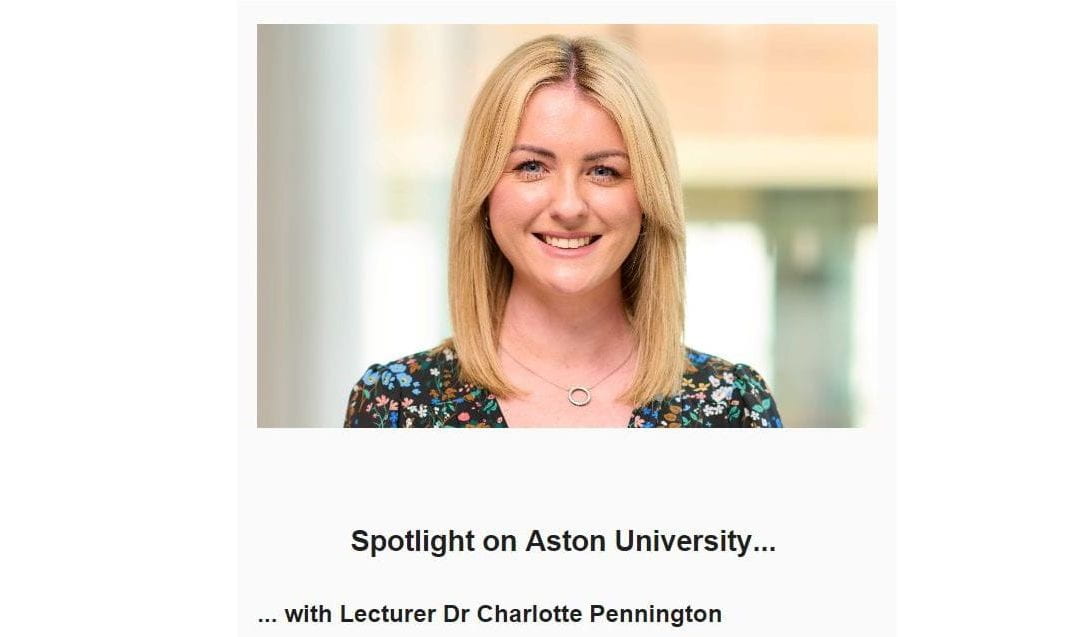Recently Diane Hird, the Local Network Lead Community Project Coordinator, met with Dr Charlotte Pennington to learn more about open research activities at Aston University and Charlotte’s experience of writing A Student’s Guide to Open Science. This blog is the result of that conversation. A huge thanks to Charlotte for her time.
Charlotte is a Lecturer based in the School of Psychology, and she has been the Aston LNL for 3 years, before which she was the LNL at UWE Bristol. Charlotte is involved in a range of activities and enjoys the freedom and flexibility she has within the LNL role.

Open research at Aston
Aston University is committed to making research “as open as possible, as soon as possible.” Their main open research information page shows how staff and students are supported in open research practices. There are links to Aston open research policies and contact details of the Open Research Team based in the Library, their staff also offer a live chat function.
As set out in their Open Research Statement, “openness in research is about more than policy compliance: it is the establishing and enacting of good practice across disciplines that allows knowledge to be accessible throughout the research lifecycle”. Staff and students are encouraged to engage with open research beyond basic policy compliance through a broad range of activities and practices. Aston acknowledge that different disciplines will engage in open research practices in different ways.
The Local Network at Aston
The Local Network has around 100 – 300 members across the university, ‘enough to pack out a lecture theatre’. Originally Psychology-focused, it has broadened to include other members from the Health and Life Sciences. Charlotte has created an open research mailing list with a contact email that redirects to her personal email, enabling her to filter out her LNL work from her other work. She also contributes information about talks or surveys to departmental and institutional newsletters.
LNL activities
Charlotte’s LNL role is mainly focused on support, education, and training. She is the first point of contact for people with questions about their open research, for example aspects of a pre-registrations and registered report submissions. She tailors the level of support and provides more advanced training where needed for example on Peer Community in. Charlotte runs workshops, gives departmental talks, and invites external speakers to the departmental seminar series. She runs a ReproducibiliTea club for MSc and PhD students, enjoying the energy of ‘getting together with a cup of tea and a brand-new paper to discuss’.
Charlotte worked with Aston Library staff to set up an open research award, establishing the criteria, opening it out to PhD students, and ensuring that open research advocates weren’t on the judging panel so they too were eligible for the award. She has been brought into work with Library staff on open research case studies and REF to provide advice and guidance around research culture and ‘the environment’.
Undergraduate student final year dissertation consortia
Charlotte has spearheaded a ‘consortium approach’ to the undergraduate dissertation project. A consortium brings final year students and supervisors from several institutions together to work on a shared project. A Cardiff, Bath, Bristol, and Exeter consortium has been running since 2017, with Charlotte being involved since 2019 at UWE Bristol and now Aston University. The consortium typically has around 5 supervisors from different universities, each with between 2 -6 students, so 15 – 20 students in total. There are both supervisior-led and team-led group meetings, which happen either in-person or online, and students can also meet 1-2-1 with their own supervisor throughout. The consortium pools their resources to overcome the limits typically associated with undergraduate final year dissertations, for example increasing the typical sample size that can be collected by individual students and overcoming the limitations of time and funding when it comes to these projects. This means more heads working on a problem, expertise and skills being shared, and makes research more efficient. The consortium typically stay within a topic area so the teams can build upon each year’s study findings and learn from past mistakes. Students learn that science is a team effort, that everyone brings their expertise to the research project. Such an approach can overcome limitations we see in the published literature, where researchers are known to publish individual student dissertations that turn out ‘well’ but not necessarily those that show null results (see O’Boyle et al., 2017, for example). By contrast, a consortium leads to a robust, large-scale publishable project. This can help graduates’ prospects because they have a pre-registered report and publication, as well as a myriad of skills that encompass ‘big team science’ (e.g., visualisation, data analysis).
These consortia can also be run internally, with supervisors and students within a department or faculty. This can be used to test the model. Whilst working at UWE Bristol, Charlotte and her colleague Kait Clark did exactly that, running a mini-consortium between them, and learning from it before going on to work with external partners.
Charlotte’s open science book
Early in her academic career (around 2015) Charlotte heard a lot about the replication crisis. There were conversations in corridors about which research areas would be exposed next, but no resolutions were being offered. Learning about open research showed Charlotte how science could be done right, and it convinced her to stay within academia. Charlotte wrote the book for her younger self, because it would have helped her understand the replication crisis and the practical steps she could take to address it in her own work. It’s a pocket guide you can take to the lab or a coffee room meeting.
In writing the book, Charlotte picked key events and research papers that were being talked about both in academia and elsewhere to illustrate the replication crisis. She was keen to address the multidisciplinary nature of the replication crisis, so although she uses Psychology-based examples Charlotte hopes that students from many other disciplines will find it useful. For example, a paper by Bem 2011 which has been described as ‘methodologically sound and logically insane’. Worth a read simply to try and get your head around.
Top tip – Merging pre-print and final paper DOIs to allow combined citations
Throughout Charlotte’s book, she offers top tips for open research practices, across preprints, preregistrations, registered reports, and open materials, code, and data. One example of this relates to preprints. Archived preprints gather citations, but when the paper is published in its final form the journal citation count starts at zero. Charlotte highlights a way to merge preprint and final paper DOIs, for example within Google Scholar, to enable these citations to be combined and tracked. This has the added benefit of tying the preprint to the final published article, so the reader can transparently see any changes between them.
Many publishers allow authors to upload the final accepted manuscript on a preprint server, and Charlotte explained how the Sherpa Romeo website provides a list of applicable journals and their guidelines. Charlotte encourages authors to update their preprint to reflect the changes made through revisions and peer review. In this way, the preprint server can host several versions of the paper, showing the incremental changes, together with the final author version which is the same as the published journal article. Google Scholar allows authors to link the DOIs from the pre-print and published version of a paper, which enables the citations from these to be pooled.
The LNL Community Project
At institutions where there is an LNL but no Institutional Lead (IL) it can be hard for the LNL to know who to go to for support. Charlotte would like to see the LNL Community Project enable LNLs to connect effectively with senior management. For example, UKRN have previously written to Vice-Chancellors of Research to identify the LNL, emphasise the voluntary nature of the role, explain their goals and activities, and the resulting the open science benefits to the institution. The letter encourages them to acknowledge the LNL and their work.
Charlotte expressed that ideally LNLs could keep in contact using a sustainable communication channel and platform for sharing information, for example Teams. In addition to informal chat spaces like Gather Town, Charlotte would like there to be more focused meetings on particular topics or an internal ReproducibiliTea to discuss a paper relevant to LNLs and/or UKRN. Anything that brings LNLs together to talk or plan events and activities would sustain the LNL community. Charlotte would also be interested in regional LNL groups or UKRN conferences as an opportunity to meet up both in-person and online.

